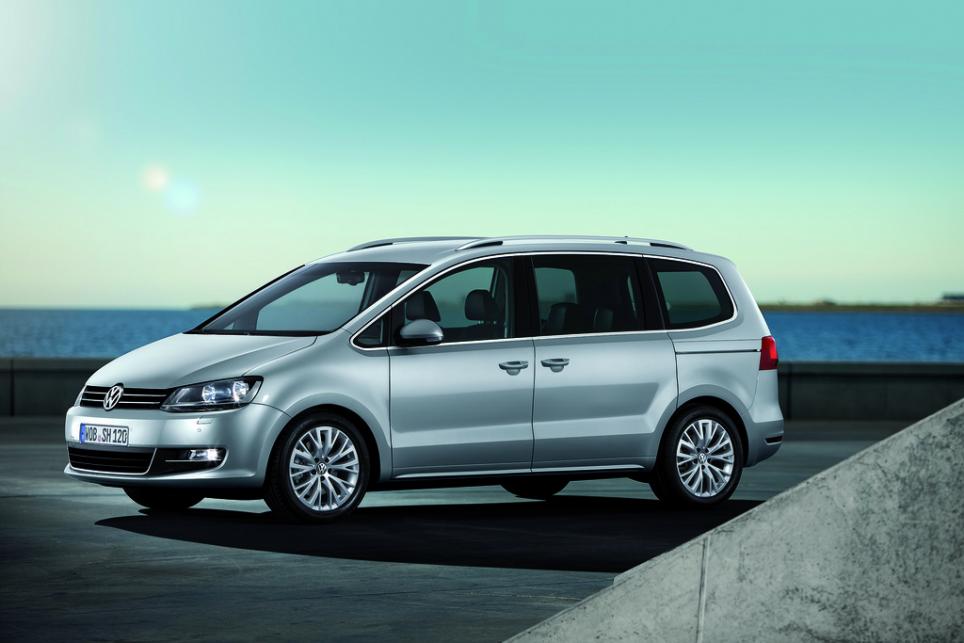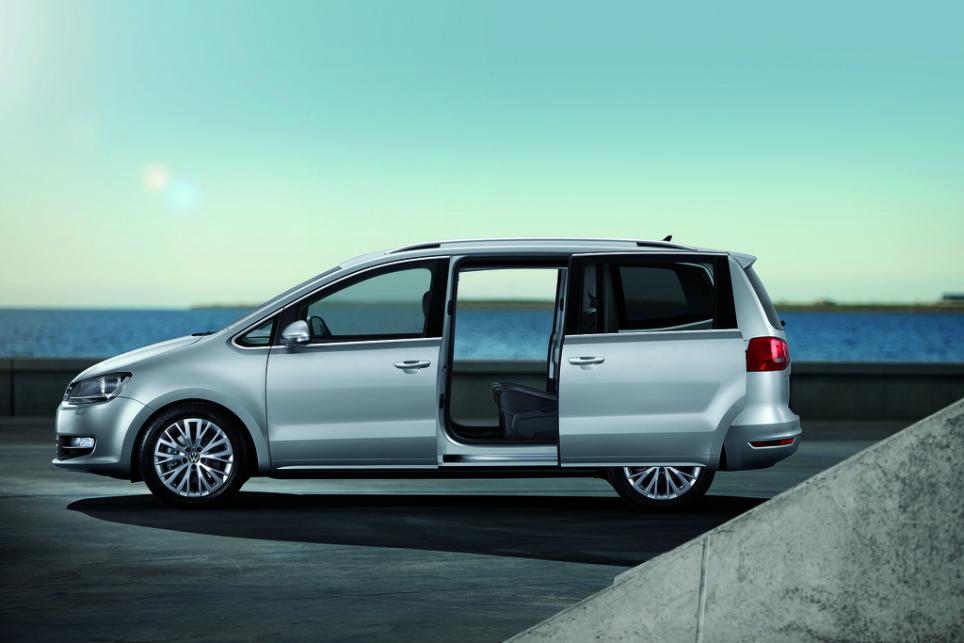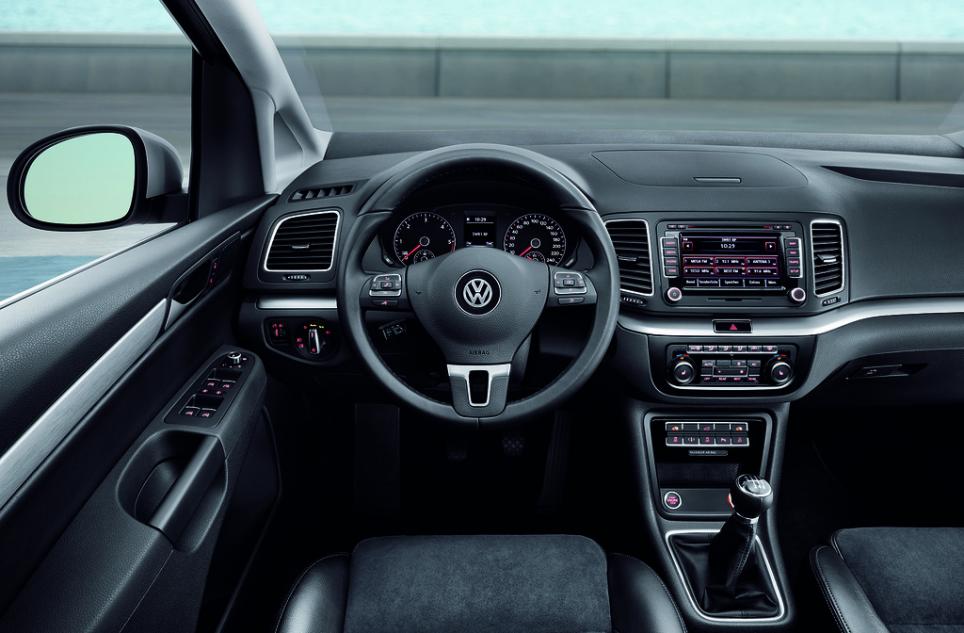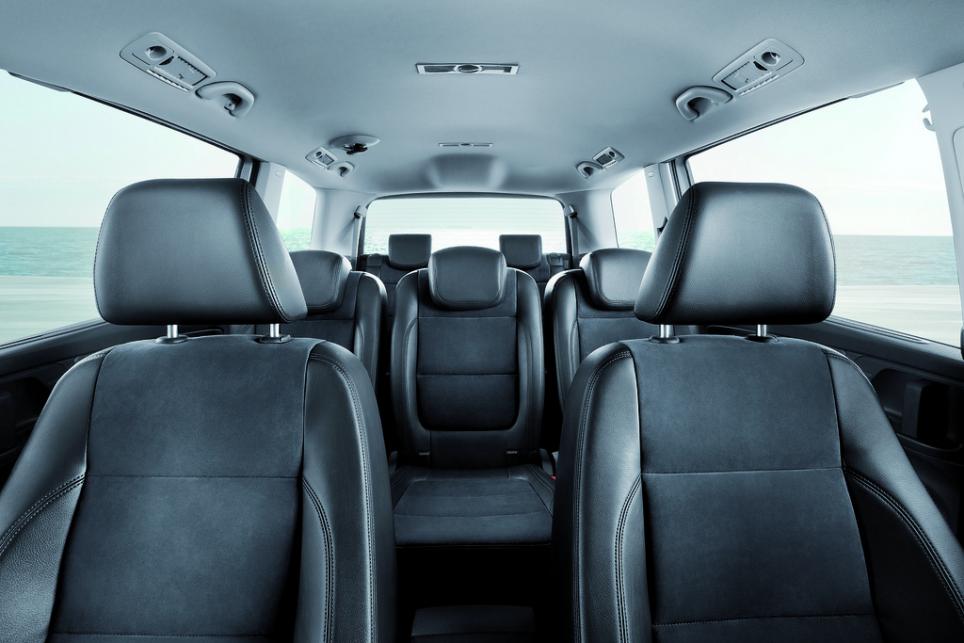
Premiere for a life on the move:
The new Sharan is the most frugal MPV of its class in the world
At 5.5 litres / 100km (51.4 British mpg), the Volkswagen sets a world best in its class for fuel economy
New ‘EasyFold’ seating concept with up to seven seats
First MPV with automatic main beam control (Light Assist)
With over 600,000 units sold, Volkswagen’s Sharan is the favourite vehicle of countless families all over Europe. Coming now, with a world premiere at the Geneva International Motor Show (4th to 14th March), is a completely new generation of this best seller. Equipped for the first time with sliding doors in the back, the 2010 Sharan has been enhanced in every area. There are only two parts that the new and the old Sharan have in common: the sun visors. That’s it! Everything else – every screw, every exterior and interior part and all of the technology, including the TDI and TSI engines (103kW / 140PS to 147kW / 200PS) and transmission systems (DSG optional) – is new. Sharan 3.0, as it were, offering world-record performance in fuel efficiency: at 5.5 litres per 100km (51,4 mpg), the 140PS Sharan 2.0 TDI achieves lower fuel consumption than any other MPV in this class.
The hallmark of the new Sharan is a complete design concept that includes the extremely flexible EasyFold seating system (up to seven easily adjustable seats), high-end quality, uncompromising safety (seven airbags, Light Assist automatic main beam control, bi-xenon headlights with LED daytime running and position light) and numerous clever details. Also new to this generation of Sharan are adaptive chassis control (DCC) and a level regulating system. This comfortable multi-purpose vehicle in the upper B segment of the market has been tailored to families with two or more children and high-mileage business users with a need for extra space.
The new Sharan’s drive and handling matches the levels of comfort and dynamic response provided by the excellent Passat. Added convenience and safety is provided by an electronic handbrake and the second-generation parking manoeuvre assistant. This means automatic steering for parking in even smaller spaces, including on pavements, between trees and even on corners, plus now, for the first time on an MPV, for parking at an angle to the traffic. Cutting edge entertainment systems, a huge, electrically operated panoramic sliding roof (with a 300% bigger opening than with a conventional sliding roof) and a powerful 3-zone climate control system guarantee great travelling conditions at any time of the year. Available in Trendline, Comfortline and Highline versions, even the base model of the Sharan is supplied with features such as semi-automatic air-conditioning (‘Climatic’) and radio/CD system (‘RCD 210’). As the only vehicle of its class to offer this, the third generation of this MPV will again be available with four-wheel drive (Sharan 2.0 TDI 4Motion with 140PS). In the first markets where it is available orders for the new Volkswagen can be placed from as early as the end of March, with the full launch beginning in the summer.
Four frugal engines
The Sharan’s four direct injection turbo petrol (TSI) and turbo diesel (TDI) engines are up to 21 percent more fuel-efficient! The two TSI engines deliver 110kW / 150PS and 147kW / 200PS, while the TDIs develop 103kW / 140PS and 125kW / 170PS. With power outputs of up to 170PS the engines use a start-stop system and energy recuperation (recovery of kinetic energy, which gets temporarily stored in the battery). With average consumption of 5.5 litres per 100km (51.4 mpg, 145g/km of CO), the 140PS version of the Sharan 2.0 TDI – top speed 194 km/h (119 mph) – sets a new benchmark for fuel efficiency in this segment of the market! The theoretical driving range is correspondingly impressive: 1,273 kilometres (805 miles) from its 70 litre fuel tank. Both TDIs are also fitted with an SCR catalytic converter (SCR = selective catalytic reduction), which specifically eliminates oxides of nitrogen (NOx) and makes the Sharan, even as a turbo diesel, one of the cleanest MPVs in the world.
For the first time, all of these Euro-5 engines will be available in combination with Volkswagen’s agile and efficient direct shift gearbox (DSG) systems – the automatics of the new age! In the case of the 200PS TSI, DSG comes as standard.
Design and dimensions
Thanks to the turbocharged petrol and diesel engines, every version of the new Sharan has gained significant extra agility. Completely new styling reinforces this. Its concise front and rear contours, in particular, plus its prominent wheel arches, create a totally new street presence. The vehicle’s relative proportions also has a more dynamic effect, with the new model – at 4.85 metres in length – being 22 centimetres longer than the old Sharan. Its width has also grown, adding 9.2 centimetres (measured from door handle to door handle at the front) to now measure 1.9 metres. At the same time its height is now 1.2 centimetres lower, at 1.72 metres. The result is a fascinating interplay of proportions and a very powerful overall impression. The reduced height, however, does not come at the expense of interior headroom.
The third generation Sharan is the company’s first MPV range to be designed by Walter de Silva (Group Chief Designer) and Klaus Bischoff (Brand’s Chief Designer) based totally on the new Volkswagen design DNA matrix. The design of the vehicle body, which is both appealing and functional, is thus epitomised by clear, horizontal lines. It is fresh, yet certainly not dictated by any transient fashion. The aim of the design is rather to create with its balanced proportions and minimal lines an ideal basis for giving the body an extremely energetic look.
Front end: Following the new DNA, the Sharan unmistakably reflects the new era Volkswagen design, especially in the typical VW front end with its strong emphasis on horizontal planes and a clearly defined shape. A very elegant look is created by the gloss black bars across the radiator grille, the integrated chrome clips and the VW logo, also in chrome. The double headlights (with daytime running lights) incorporated into the V-contour of the bonnet can be ordered both in the standard and bi-xenon versions. In addition, as a new feature on the Sharan, there will also be a further headlight version with automatic main beam control (Light Assist). Based on a camera system, this dynamic main beam regulator detects both oncoming traffic and the vehicles in front and adjusts the beam such that nobody gets blinded (the headlight is partially masked) and the best possible illumination of the carriageway can also be achieved for the driver. If the Sharan is ordered with bi-xenon headlights, a newly designed LED daytime running and position light is also included within the headlamp module. It is made up of 15 individual LEDs that are positioned inside the module in a concise pattern.
Under the body-coloured bumper is a further air inlet and, on the left and right, fog lamps with optional indicator light function (standard on the Sharan Highline). Varying by equipment line, Volkswagen uses chrome trim in this area as well. If the Sharan is ordered with bi-xenon lights, the indicator light function is integrated there within the headlamp module.
Rear end: The rear look of the Sharan is just as clearly structured as that of the front. The visually dominant elements here are the concise roof-edge spoiler, the very deep tailgate (sill height: 0.67 metres) and the very large rear lights, which match the headlamps and also create an unmistakable appearance at night. The tailgate itself can optionally be opened and closed electrically.
Side profile: A distinctive feature of the Sharan is its smooth side profile. The background to this is that in designing the Sharan, De Silva and Bischoff put particular emphasis on the homogeneity of the vehicle’s surfaces, as – allied to the relatively long wheelbase of 2.92 metres and the MPV’s overall length – it makes the integration of the sliding doors perfect. The position of the door handles to the left and right of the B-pillar is extremely practical, as it enables the driver or passenger to open the front or rear door with single movement of the hand, without changing position. Anyone with small children in tow will appreciate this feature! The fact that the sliding doors open to the rear also creates an extremely large opening and thus easy access into the back.
The designers also gave a unique feel to the geometric, clearly defined look of the side windows. They sit relatively low on the vehicle, conveying a sense of airiness and transparency. The bottom edge of the row of windows rises dynamically at front and rear, giving the roof’s A and D pillars a character of their own.
- Ben
1961 Karmann Ghia Coupé - 1993 Golf Cabriolet - 2006 Golf Comfortline 1.9L TDI
2008 Jetta 2.0L FSI






 Reply With Quote
Reply With Quote








Bookmarks